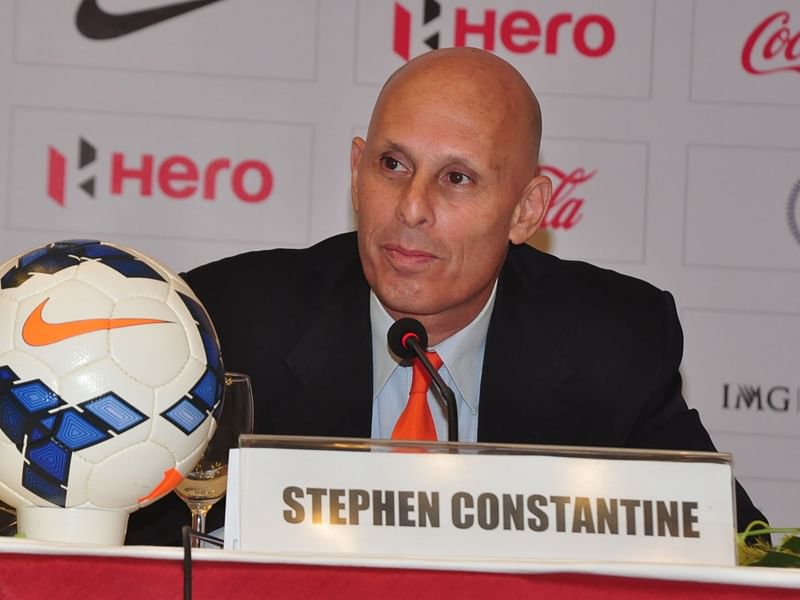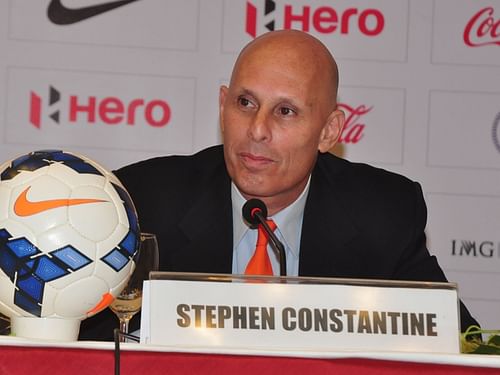
Stephen Constantine's arrival heralds the beginning of new era in Indian football

Stephen Constantine’s second coming as National coach got off to a brisk start with an emphatic 2-0 win over Nepal in the 2018 FIFA World Cup Qualifiers Preliminary Joint Qualification Round 1 match on March 12 at the Indira Gandhi stadium, Guwahati.
The new coach is being hailed for starting with four debutants and overall using seven new players in the match. The selection in defence was bold with right-back Pritam Kotal, central defender Sandesh Jhingan and left-back Saumik Dey making their debuts.
Bold team selection a refreshing change
East Bengal’s Saumik has finally been rewarded for nine years of consistent service to his club. In all probability, at the age of 30 he is the oldest debutant to play for India. Saumik deserved an Indian cap but was lucky to get one as first choice left-backs Narayan Das (who is out for the season) (Dempo) and Gurjinder Kumar (Pune FC) were both injured.
Similarly, right-back Pritam Kotal (Mohun Bagan) is highly rated and will soon be a regular in this position. However, he also got his chance because regular international right-back Denzil Franco got injured in the Hero ISL and is out for the season.
The choice of midfield dynamo Eugenson Lyngdoh in place of Mehtab Hossain was an inspired selection. The 28-year-old Lygdoh studied at Bishop Cotton School, Bangalore but made his club debut for Shillong Lajong FC and last season played for Rangdajied United.
He joined Bengaluru FC this season and the expert coaching Ashley Westwood and the guidance of fellow professional Joshua Walker (a former England U-20 international) has transformed his game. The quiet and soft spoken Lyngdoh is technically very good, has exemplary workrate and glides past opponents to score vital goals.
A late developer, he brought greater mobility to the Indian midfield and should be a regular in the national team for some years. During the Hero I-League matches, Walker had predicted that Lyngdoh would make his international debut and he proved to be quite clairvoyant.
The three substitutes Jackichand Singh, who had a goal disallowed, Cavin Lobo and Holicharan Narzary also made their India debuts and were picked on current form.
Credit to Constantine and his assistant coaches S Venkatesh and Savio Madeira. Incidentally Venkatesh was chosen due to his proximity to the new national coach even though he only has a C license coaching degree.
Introduction of new players to the national team set-up a recurring trend
Constantine is being hailed for being an astute judge of players and choosing exciting new talent. But this trend was started in 2012, when at the 15th Nehru Cup, the previous coach Wim Kovermans introduced six new players.
The debutants in 2012 were winger Sanju Pradhan, strikers Robin Singh and Manandeep Singh, midfielders lanky Lenny Rodrigues, the highly-rated Alwyn George and defender Gurwinder Singh.
The 52-year-old Dutch coach Wim Koevermans was the first national coach to make so many changes to the national squad. In contrast, when Bob Houghton took over in the summer of 2006, he introduced new players to the national side gradually. Kovermans had been forced to introduce changes due to two reasons.
The generation of players, defenders Deepak Mondal, Mahesh Gawli and Samir Naik, midfielders Climax Lawrence, NP Pradeep and strikers Baichung Bhutia and Abhishek Yadav who did great service for India in the first decade of the 21st century had all retired from international football.
Some others who were regulars in Houghton’s squad, like right-back Surkumar Singh, central defenders Anwar, Govin Singh and striker Sushil Kumar Singh were not in good nick and so were omitted and have never made a comeback.
Unfortunately, of the six players that Koevermans introduced to international football, only two cemented their place in the national squad, midfielder Lenny Rodrigues and striker Robin Singh. Both played in Koevermans’ last match in charge of the national team on 7th October 2014, the 2-3 loss to Palestine at Siliguri.
Striker Manandeep’s career has been stalled due to injuries. Both Sanju Pradhan and Alwyn George had immense potential but have not fulfilled the promise that they had initially shown.
Sturdy defender Gurwinder has been unfortunate that he does not get regular playing time at his club East Bengal also. When Gurwinder joined East Bengal in August 2010, the Nigerian Uga Okpara was a first choice for East Bengal. Their then coach Trevor Morgan opted for either Gurwinder or Raju Gaikwad to play alongside him.
Later, Arnab Mondal joined the club and became the first choice central defender alongside Okpara or Milan Susak, the 30-year-old Serbian Australian who has joined the Kolkata club this season.
Consequently, Gurwinder’s international career has got stalled. India needed a solidly built central defender but that place is now being filled up by a younger and faster Sandesh Jhingan.
Emergence of youth bodes well for the future
In the current Indian squad, both Jhingan (from Chandigarh) and Kotal (from Bengal) had played in the 2014 Incheon Asian Games for the national U-23 team. They are both products of the Youth Development Programme (YDP), initiated by the All India Football Federation (AIFF) some years ago which is now paying dividends.
Speedy winger Narzary from Kokrajhar, Assam also came into the limelight through this system. Both Jackichand Singh and Cavin Lobo are products of youth development programmes in Shillong and Goa respectively.
India have made a good start to their 2018 World Cup qualifying campaign but they have to play a tough away match in Kathmandu on March 18. Hopefully Sunil Chettri’s missed penalty kick will not prove costly.
But, the emergence of quality players from youth development programmes of the AIFF and clubs augurs well for the future and is a trend that should be strengthened.